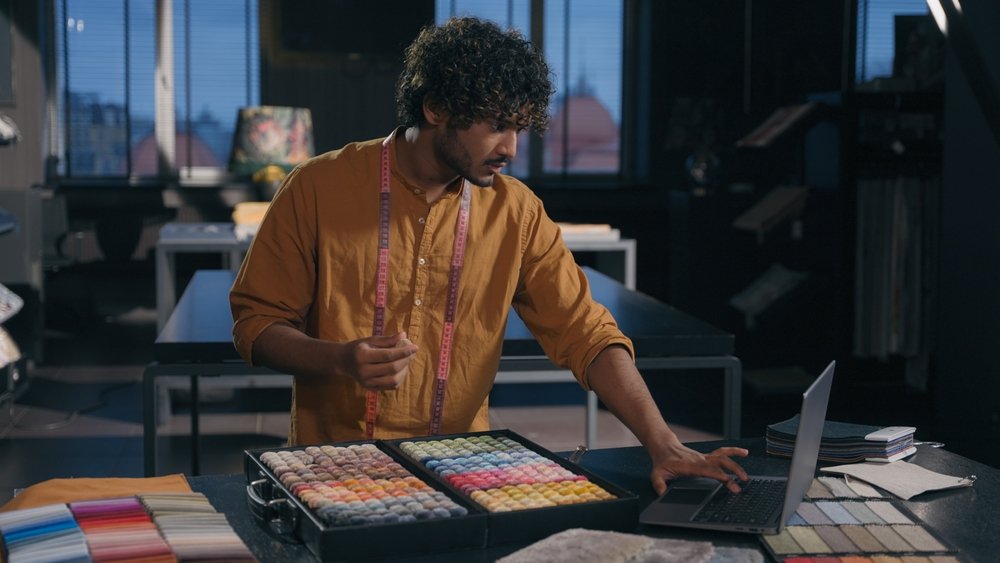
Choosing the right lace trim is crucial for manufacturers, fashion designers, and exporters. With a wide variety of lace types available—each offering distinct characteristics in design, functionality, and cost—it can be challenging to determine which one best suits your product. In this guide, we’ll walk you through the most common lace varieties, their ideal applications, and key selection criteria to help you make informed decisions for Pakistani textile production.
1. Crochet Knitted Lace
What it is:
Crafted on crochet knitting machines, this lace offers intricate, soft-textured patterns with artisanal charm. It sits between hand-made and warp-knitted designs in terms of detail and cost.
Best for:
- Bridal gowns, abayas, scarves
- Babywear and delicate children’s clothing
- Home décor like curtains, cushions, table linens
Why choose it:
- Soft hand feel and detailed aesthetics
- Suitable for mid-sized to small volume orders
- Closes the gap between couture quality and machine efficiency
2. Raschel Lace
What it is:
Produced on Raschel warp-knitting machines, this lace offers precision-engineered patterns at high speeds. Known for its durability and design consistency.
Best for:
- Mass production of bridal and evening wear
- Home textiles and ready-to-wear garments
- Accessories like belts, handbags, and shoes
Why choose it:
- Uniform quality for high-volume export orders
- Faster turnaround and cost-effective production
- Great for detailed patterns that need repeatability
3. Embroidered & Fabric Embroidery Lace
What it is:
Intricate lace stitched onto a base fabric (tulle, organza, cotton) using computerized embroidery machines.
Best for:
- Luxurious bridal wear and formal gowns
- Ethnic wear like shalwar kameez and dupattas
- Fashion-forward home textile collections
Why choose it:
- Highly detailed and visually rich patterns
- Customizable to match color palettes or brand themes
- Ideal for premium and export-orientated designs
4. Die Cut Lace
What it is:
Cut from fabric using precision dies or laser-cutting tools, creating sharp-edged lace designs.
Best for:
- Structured gowns and party wear
- Geometric or minimalist fashion lines
- Curtain inserts and contemporary décor pieces
Why choose it:
- Crisp design aesthetics
- Extremely precise edges for clean results
- Custom design options without thread-based complexity
5. Chemical (Burnout) Lace
What it is:
Made via a chemical process (burnout), which dissolves selected areas of fabric to reveal intricate lace-like designs.
Best for:
- High-end bridal collections
- Luxury abayas, scarves, or evening wear
- Artistic home décor accents
Why choose it:
- Delicate, almost three-dimensional patterns
- Smooth, sophisticated finish
- Popular for elegant, statement-making products
6. Braided Lace
What it is:
Constructed by intertwining multiple strands of yarn or thread into strong, decorative cords.
Best for:
- Garment trim for trousers, shalwar kameez, abayas
- Accessory design – belts, hats, bags
- Home textiles and packaging décor
Why choose it:
- Durable and flexible
- Decorative element that doubles as a functional trim
- Available in various widths and patterns
7. Handicrafted Lace
What it is:
Entirely hand-made using traditional techniques like crochet, branching off into unique, artisanal designs.
Best for:
- Haute couture and one-off bridal gowns
- Boutique collections and artisanal home décor
- Luxury accessories and limited-edition pieces
Why choose it:
- Unmatched he artisanal value and exclusivity
- Slight irregularities lend character and appeal
- Ideal for products with an artisan or heritage aesthetic
Key Factors to Consider
When choosing lace, evaluate these essential criteria:
- Design & Aesthetic – Is a soft crochet look, crisp die-cut, or ornate embroidered style a better fit?
- Volume & Scale – Small boutiques may choose crochet, while exporters may favor Raschel for bulk.
- Cost & Budget – Factor in material, design complexity, and labor—hand-made options are more expensive upfront.
- Production Timeline – Machine methods produce faster; handmade adds lead time.
- Durability – Consider how the lace will perform through wears and washes.
- Target Market – Export lines may need precise, repeatable machine-made designs; local couture can leverage handmade accents.
When to Use Hybrid Solutions
For the best of both worlds:
- Machine-made base + hand embellishment – Efficient foundation with premium finish
- Raschel lace + chemical effect – Combining structural strength with design intricacy
- Embroidery + die cut highlights – Layering for texture contrast and visual impact
This approach benefits brands seeking unique appeal on a manageable budget.
How Mehran Enterprise Supports Your Needs
At Mehran Enterprise, we offer an extensive range of lace options:
- Crochet, Raschel, Braided, Embroidered, Die Cut, Chemical, and Handicrafted laces
- Custom design capabilities for exclusive patterns, colors, and materials
- Production facilities in Karachi, Lahore, Faisalabad, Sialkot, and Multan
- Dedicated support from concept to delivery, tailored to both local designers and export manufacturers
Conclusion
Choosing the right lace type not only enhances product quality but also defines your brand’s identity. Whether it’s the artisanal charm of handicrafted lace or the precision of Raschel, aligning your choice with design vision, production capacity, and cost constraints is key.
Need help deciding?
Contact Mehran Enterprise for expert advice on the best lace types for your garment, accessory, or décor project—customized to meet your unique production requirements.
